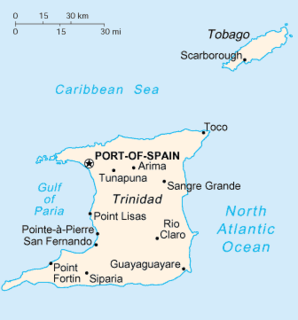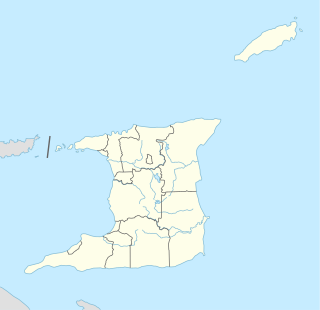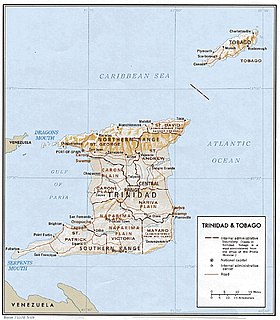
Trinidad and Tobago is an archipelagic republic in the southern Caribbean between the Caribbean Sea and the North Atlantic Ocean, northeast of Venezuela. They are southeasterly islands of the Lesser Antilles, Monos, Huevos, Gaspar Grande, Little Tobago, and St. Giles Island. Trinidad is 11 km (6.8 mi) off the northeast coast of Venezuela and 130 km (81 mi) south of the Grenadines. The island measures 4,768 km2 (1,841 sq mi) in area with an average length of 80 km (50 mi) and an average width of 59 km (37 mi). The island appears rectangular in shape with three projecting peninsular corners. Tobago is 30 km (19 mi) northeast of Trinidad and measures about 298 km2 (115 sq mi) in area, or 5.8% of the country's area, 41 km (25.5 mi) in length and 12 km (7.5 mi) at its greatest width. The island is cigar-shaped in appearance, with a northeast-southwest alignment.

Port of Spain, officially the City of Port of Spain, is the capital city of Trinidad and Tobago, the country's second-largest city after San Fernando, and the third largest municipality after Chaguanas and San Fernando. The city has a municipal population of 37,074, an urban population of 81,142 and a transient daily population of 250,000. It is located on the Gulf of Paria, on the northwest coast of the island of Trinidad and is part of a larger conurbation stretching from Chaguaramas in the west to Arima in the east with an estimated population of 600,000.

Trinidad is the larger and more populous of the two major islands of Trinidad and Tobago. The island lies 11 km (6.8 mi) off the northeastern coast of Venezuela and sits on the continental shelf of South America. It is often referred to as the southernmost island in the West Indies. With an area of 5,131 km2 (1,981 sq mi), it is also the fifth largest in the West Indies.

The Asa Wright Nature Centre and Lodge is a nature resort and scientific research station in the Arima Valley of the Northern Range in Trinidad and Tobago. The centre is one of the top birdwatching spots in the Caribbean; a total of 256 species of birds have been recorded there. The centre is owned by a non-profit trust.

El Cerro del Aripo, at 940 metres (3,084 ft), is the highest point in the Republic of Trinidad and Tobago. It is part of the Aripo Massif and is located in the Northern Range on the island of Trinidad, northeast of the town of Arima.

Caroni County is a historic county of Trinidad and Tobago. It occupies 557 km2 (215 sq mi) in the west central part of the island of Trinidad, the larger island in the Republic of Trinidad and Tobago. It lies south and southwest of Saint George County, west of Nariva County and north of Victoria County. To the west it is bounded by the Gulf of Paria. County Caroni includes the towns of Chaguanas, the largest town in the country and Couva, the capital of the Couva–Tabaquite–Talparo region. Administratively it is divided between the Borough of Chaguanas, the Couva–Tabaquite–Talparo Regional Corporation and the Tunapuna–Piarco Regional Corporation. The county was divided into four Wards: Chaguanas, Couva, Cunupia and Montserrat. The major towns of County Caroni are Chaguanas and Couva. The port and industrial zone of Point Lisas is located in Caroni, and the region is also a site for agriculture.

The Panyols are a Pardo (tri-racial) ethnic group in Trinidad and Tobago of mixed Spanish, South American Amerindian, Trinidadian and Tobagonian Amerindian, Afro-Latin American, and Afro-Trinidadian and Tobagonian descent. They comprise the Cocoa Estate Plantations owners community along with peasant workers from Venezuela and Colombia, also referred to as Pagnols, local Spanish, Cocoa panyols. They were born of the shared Island nation, on both sides of the Gulf of Paria, Peninsulas that settling within the Northern Range Rain Forest Mountains Valleys of Trinidad and Tobago Caura River, down the mountains into the Tacarigua River into the Caroni River, and the Orinoco, and Caura River, Venezuela. They played an important role in the development of the cocoa industry in Trinidad and Tobago, running the Cocoa Estate and not to be confused with the freed community of former slaves.

The Caroni River is the largest river in Trinidad and Tobago, running for 40 km (25 mi) from its origins in the Northern Range on the island of Trinidad, through the northern lowlands of the Caroni Plains and enters the Gulf of Paria at the Caroni Swamp.

Saint George is a county in Trinidad and Tobago. It occupies the northwestern portion of the island of Trinidad and is bounded by the Caribbean Sea to the north, the Gulf of Paria to the west, Caroni County to the south and Saint David County and Saint Andrew County to the east. It occupies an area of 912 km2 (352 sq mi). The county includes the Bocas Islands and the towns of Port of Spain and Arima. It also includes the small town of Blanchisseuse and its attractive beach, backed by a forest-fringed lagoon. County Saint George is divided into six Wards: Diego Martin, Saint Ann's, Blanchisseuse, Tacarigua, Arima and San Raphael.
Maracas–Saint Joseph is a colloquial name used in Trinidad and Tobago to distinguish the Maracas Valley above the town of Saint Joseph from Maracas Beach. Maracas–Saint Joseph is one of the large valleys on the southern side of the Northern Range, while Maracas Beach lies on the opposite side of the mountains.

El Tucuche is the second highest peak in Trinidad's Northern Range and is noted for its interesting pyramidal shape. It is fabled in Amerindian lore as a sacred mountain. There are Amerindian petroglyphs on a rock outcrop below the mountain. These are the only petroglyphs found in the country.

The Central Range is a mountain range on the island of Trinidad. It extends diagonally across the island and is a low-lying range with swampy areas rising to rolling hills. The tallest hills are Mount Tamana, Mount Harris and Brigand Hill, all located in the northeastern portion of the range. The Central Range mountains are biodiverse, and are home to the Tamana Caves. Trinidad's, as well as one of the world's largest bat colony is located here. Howler monkeys can be found here and numerous species of birds as well.

Tunapuna–Piarco is one of the 9 regions of Trinidad and Tobago. It is the most populous region in the country by total population and the fifth-largest by total land area. Geographically located in Northern Trinidad, Tunapuna–Piarco shares its borders with the regions of San Juan–Laventille to the west, Couva–Tabaquite–Talparo to the south, the Borough of Chaguanas to the south-west, Sangre Grande to the east and the Caribbean Sea to the north. The region also completely surrounds the Royal Chartered Borough of Arima, which is located in the south-eastern corner of the region.

Maracas Valley is a valley in Trinidad that is separated by two mountains between Maracas–Saint Joseph and Maracas Beach.
Phytotriades is a genus of tree frogs in the family Hylidae. As currently delimited, the genus is monotypic and contains Phytotriades auratus, commonly known as the golden tree frog, bromeliad-dwelling treefrog, El Tucuche golden tree frog, or Trinidad heart-tongued frog.

The following is an alphabetical list of topics related to the Republic of Trinidad and Tobago.

Heights of Aripo Village is located in the Northern Range of the island of Trinidad. It is presumed this village, which lies in known Amerindian territory of the Nepuyo people, was at one point inhabited by first peoples. The work provided by later Cocoa Estates would have been a major draw for labour and settlers in the twentieth century. Few of the Estate houses remain many Cocoa Houses are still visible in the community either repurposed and inhabited or dilapidated. Most of the villagers have moved away from cocoa production, agricultural production still remains a big part of the community. The area is now the second largest producer of watercress on the island and the village has been working with The Caribbean Natural Resources Institute (CANARI) to further business opportunities for the village and help its sustainability.


















